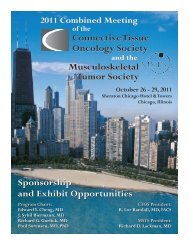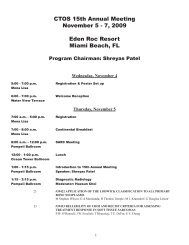Scientific <strong>Poster</strong>s – <strong>Poster</strong> <strong>Session</strong> 2advanced sarcomas (excluding gastrointestinal stromaltumors) were analyzed: leiomyosarcoma, n=25; Ewingsarcoma, n=18; spindle cell sarcoma, n=16; desmoplasticsmall-round-cell tumor, n=15; liposarcoma, n=12; chondrosarcoma,n=8; synovial sarcoma, n=6; osteosarcoma,n=5; alveolar soft part sarcoma, n=5; angiosarcoma, n=4;PEComa, n=3; clear cell sarcoma, n=4; pleomorphic unclassifiedsarcoma, n=3; and others or unclassified, n=14.At least one tested aberration was found in 25 (18%) ofpatients with diverse sarcoma subtypes: BRAF mutationin 1 patient, EGFR mutations in 2 patients, MET mutationsin 5 patients, TP53 mutations in 11 patients, PIK3CA mutationsin 2 patients and PTEN loss in 5 patients (Table).None of the patients had KIT, KRAS or NRAS mutations.Six patients received matched targeted therapy (PIK3CAmutation -> PI3K inhibitor, n=1; EGFR mutation -> EGFRinhibitor, n=1; MET mutation -> MET inhibitor, n=1; PTENloss -> mTOR inhibitor, n=3) and one patient with uterineleiomyosarcoma and PTEN loss treated with temsirolimusexperienced stable disease ≥ 6 months (8.7 months).Conclusion: Actionable aberrations can be detected insmall subsets of sarcomas and warrant further investigationof their utility for therapeutic decision-making.Molecular Aberrations and Sarcoma SubtypesMolecularaberrationSarcoma type (number with aberration)BRAF Epithelioid high-grade sarcoma (1)EGFR Spindle cell sarcoma (1), undifferentiated sarcoma (1)METAngiosarcoma (1); desmoplastic small-round-cell tumor (1); Ewing sarcoma (1); myxoid liposarcoma (1);spindle cell sarcoma (1)PIK3CA Atrial angiosarcoma (1); desmoplastic small-round-cell tumor (1)PTENTP53Leiomyosarcoma (2); Ewing's sarcoma (1); chondrosarcoma (1);malignant peripheral nerve sheath tumor (1)Leiomyosarcoma (4); hemangiopericytoma (1); pleomorphic unclassified sarcoma (1); clear cell sarcoma(1); spindle cell sarcoma (1); chondrosarcoma (1); angiosarcoma (1), undifferentiated sarcoma (1)<strong>Poster</strong> #173PRECLINICAL ACTIVITY OF THE COMBINATIONOF GEMCITABINE AND RAPAMYCIN INSARCOMASJuan Martín Liberal; Miguel Sáinz-Jaspeado;Laura Lagares-Tena; Xavier García del Muro;Òscar M. TiradoSarcoma Research Group, Institut d’Investigació Biomèdicade Bellvitge (IDIBELL), Barcelona, SpainObjective: Few active drugs are available for the treatmentof sarcomas. Moreover, these drugs have poor activity andclinical results still remain very disappointing. Thus, thereis a need to find new therapeutic alternatives in order toimprove patient’s outcome. Gemcitabine is a drug withvery limited efficacy in monotherapy but its favorable toxicityprofile allows its combination with other compounds.mTOR pathway plays a key role in normal cell processesbut its malfunction leads to defective cell proliferationand survival in many human malignancies including sarcomas.Therefore, in this study we assessed the activity ofthe combination of Gemcitabine with an mTOR inhibitor(Rapamycin) in vitro and in vivo.Methods: Two representative sarcoma cell lines wereused: SKLMS-1 (leiomyosarcoma) and SW982 (synovialsarcoma). Both cell lines were treated with Gemcitabineand Rapamycin separately, sequentially and in combination.Cell proliferation and cell death were determinedby the Trypan Blue exclusion assay. An apoptosis marker(Caspase 3) and 2 mTOR inhibition markers (pS6 andp4EBP) were assessed by Western-Blot. For the in vivoexperiments, a murine xenograft model of leiomyosarcomawas established by subcutaneous injection of SKLMS-1cells in athymic mice. Once tumors reached a significantvolume, animals were treated with: Gemcitabine, Rapamycinand Gemcitabine followed by Rapamycin. Tumorswere removed and immunohistochemistry (IHC) to detectcleaved Caspase 3 and pS6 expression was performed intumor sections.Results: Cell proliferation and death determined after48h of treatment resulted in an additive effect of the combinationon both cell lines. Results showed activation ofCaspase 3 in cells treated with the combination comparedwith those treated with 1 drug alone. Furthermore, sequentialcombination enhanced apoptosis compared with theadministration of both drugs at the same time. pS6 inhibitionwas also stronger with the combination than witheither of the drugs alone. The in vivo experiment showed258
Scientific <strong>Poster</strong>s – <strong>Poster</strong> <strong>Session</strong> 2a significant decrease in tumor growth in mice treated withboth drugs. IHC of pS6 and Caspase 3 revealed highestinhibition of mTOR pathway and enhanced apoptosis inmice treated with the combination, similarly to resultsobserved in vitro.Conclusion: Combination of Gemcitabine and Rapamycinshowed intense activity in preclinical sarcoma models andwarrants further investigations. A clinical trial exploringthe efficacy of this regimen in patients with sarcomas iscurrently ongoing.<strong>Poster</strong> #174ACTIVITY OF CYTOTOXIC CHEMOTHERAPY INMETASTATIC SOLITARY FIBROUS TUMOR:A SINGLE-CENTER REVIEWThierry Alcindor, Md, MSc 1 ; Ayoub Nahal 2 ; Robert Turcotte 31<strong>Oncology</strong> and Medicine, McGill University Health Centre,Montreal, QC, Canada; 2 Pathology, McGill University HealthCentre, Montreal, QC, Canada; 3 Orthopaedic Surgery, McGillUniversity Health Centre, Montreal, QC, CanadaObjective: Solitary fibrous tumour is a rare type of sarcomathat infrequently metastasizes. No standard treatment isrecognized for it, although clinical trials with molecularlytargeted agents are underway. A recent paper (Park MS etal. in Cancer 2011. Nov 1) documents activity of the temozolomide/bevacizumabcombination in locally advanced,recurrent and metastatic presentations of this disease. InCanada, bevacizumab is not approved for this indication.In the absence of available clinical trials, we hypothesizedthat both doxorubicin, a drug with broad activity againstsarcomas, and dacarbazine, of which temozolomide is aprodrug, would have clinical activity in solitary fibroustumour.Methods: A retrospective chart review was performed,from a prospectively maintained database of sarcoma patients.Inclusion criteria were: histologic proof of diagnosisof solitary fibrous tumor, measurable metastatic disease,administration of doxorubicin and/or dacarbazine, ineither first or second line. Patients underwent regularassessment of response by CT scans, every 3 months. Patientswith totally resected tumors, and those with locallyadvanced nonmetastatic disease were excluded.Results: Four patients meeting inclusion criteria were includedin the present study, referred to the Medical <strong>Oncology</strong>Clinic between 2009 and 2011. Demographics were asfollows: males/females (2/2), age range 37-79 years, WHOperformance status 1-2. All diagnoses were confirmed bybiopsy of the primary tumor. In two cases, the metastaticlesions were also biopsied and found to be histologicallysimilar to the primary tumor. First-line treatment consistedof dacarbazine in 3 patients, doxorubicin in 1. In first-linesetting, dacarbazine achieved disease stabilization/minorradiological response for 6 to 12 months in all 3 patients.Doxorubicin administration also resulted in prolongeddisease stabilisation (longer than 6 months) in 2 patients (1in 1st line, 1 in 2nd line). Following further disease progressionor after disease stabilisation, patients have undergonecytoreductive surgery (1 patient), tumor embolization (1patient) or chemotherapy change to sorafenib (1 patient).Conclusion: While our study is limited by its small sizeand the lack of a control group, our results suggest benefitin metastatic solitary fibrous tumor from conventionalchemotherapy. The effects of the addition of bevacizumabto standard chemotherapy should be studied in a randomizedtrial.<strong>Poster</strong> #175IMPACT OF IMMEDIATE CYTOLOGICALEVALUATION ON THE SUCCESS RATE OF NEEDLEBIOPSY IN BONE AND SOFT TISSUE LESIONSShintaro Iwata 1 ; Tsukasa Yonemoto 1 ; Tetsushi Hirata 2 ;Akinobu Araki 2 ; Makiko Itami 2 ; Takeshi Ishii 11Div. Orthopedic Surgery, Chiba Cancer Center, Chiba,Japan; 2 Div. Surgical Pathology, Chiba Cancer Center,Chiba, JapanObjective: The diagnostic accuracy of a needle biopsy inbone lesions is lower than that in other lesions. In our hospital,immediate cytological evaluation (ICE) is performedin order to ensure the adequacy of samples in each sessionof the biopsy. The aim of this study was to evaluate theimpact of ICE on the success rate of needle biopsy in boneand soft tissue lesions.Methods: From 2005 to 2011, 977 consecutive needle biopsysessions were undertaken, comprising 441 (45%) bonelesions, 513 (53%) soft tissue lesions, and 23 combinedlesions. All needle biopsy procedures were performed byexperienced orthopedic oncologists under CT-guidance.Touch print was carried out with glass slides from theobtained samples, and evaluated by cytoscreeners immediatelywhether it demonstrated adequate cells expectedfor the tumor tissue; if not, the biopsy was repeated. Thesuccess rate was calculated based on the number of biopsyfailures, which was defined as: 1) inadequate material, 2)normal tissue only, and 3) diagnostic discrepancy betweenbiopsy and resected specimen.Results: The success rate of needle biopsy was 96.8% (946lesions). There were 31 biopsy failures including 9 inadequatematerials, 16 normal tissues only, and 6 diagnosticdiscrepancies; bone lesions were 17, and soft tissues were14. There was no difference in the success rate among the259






